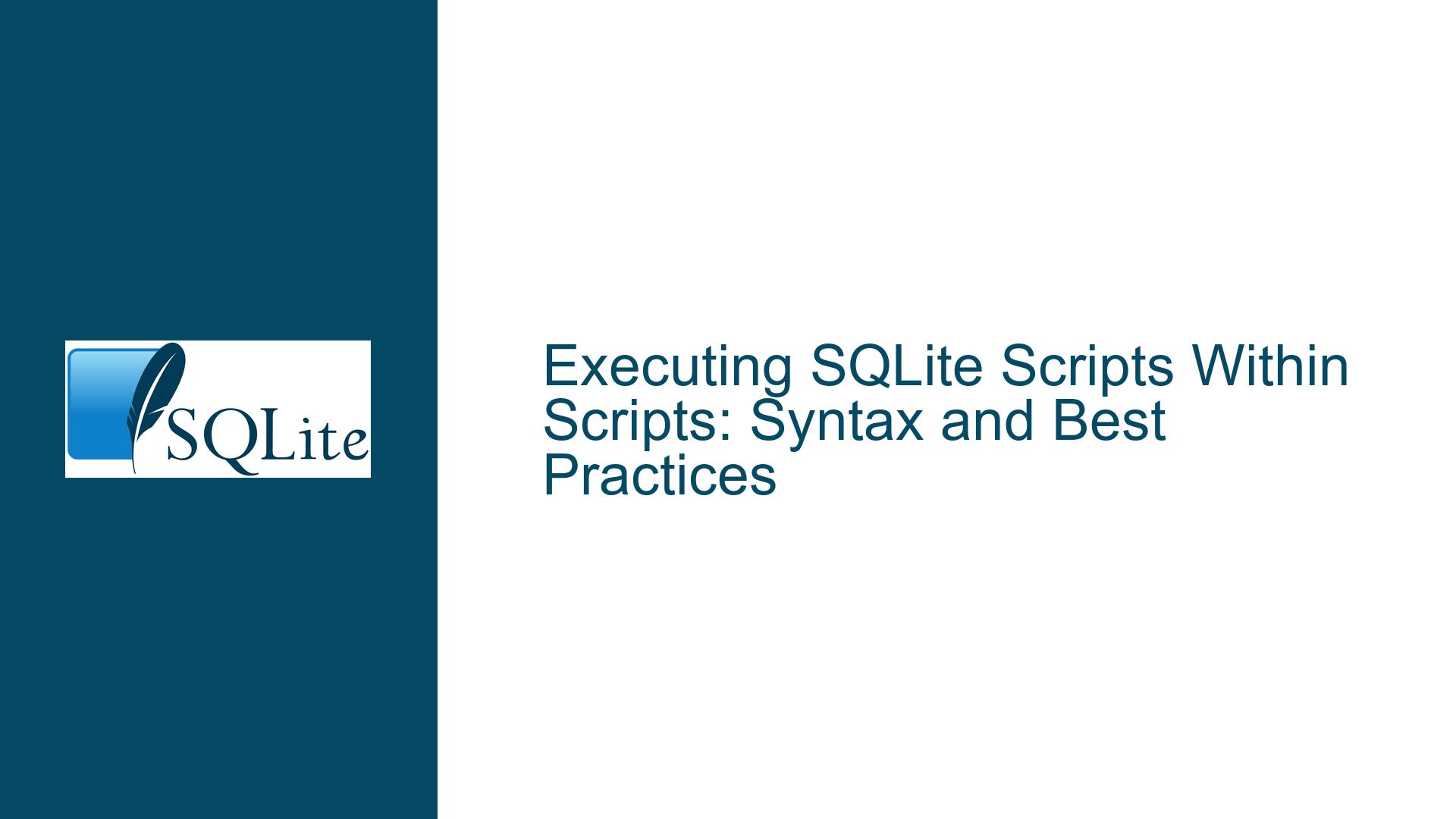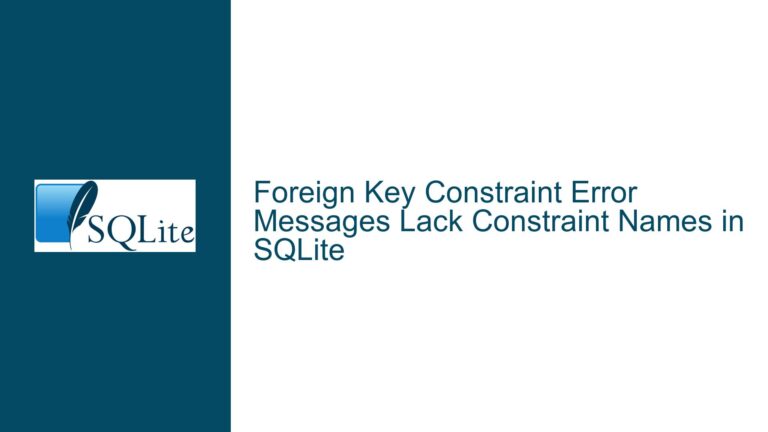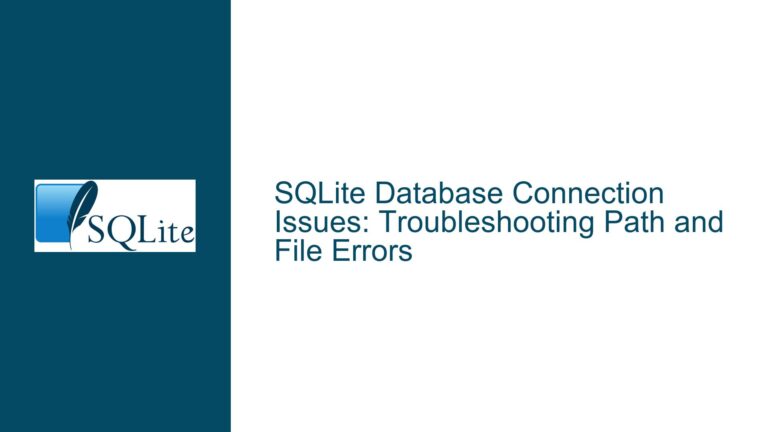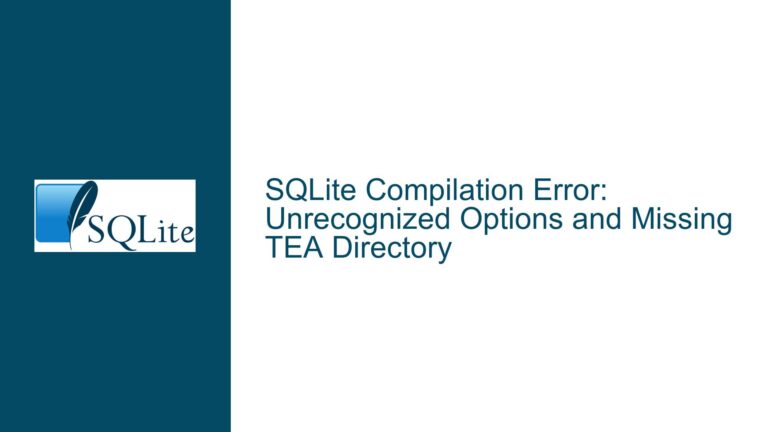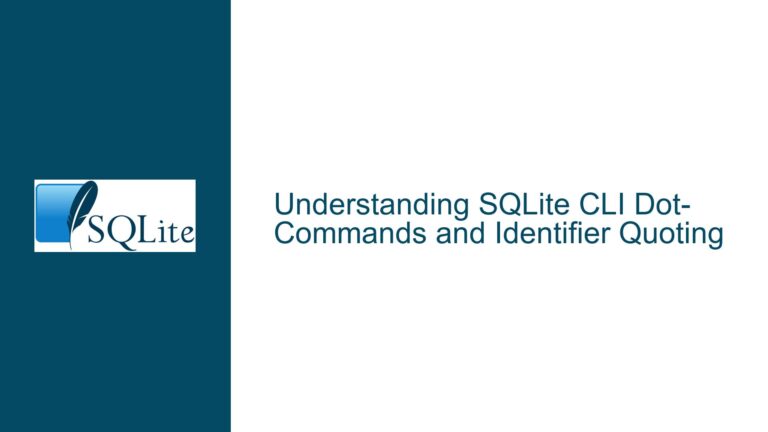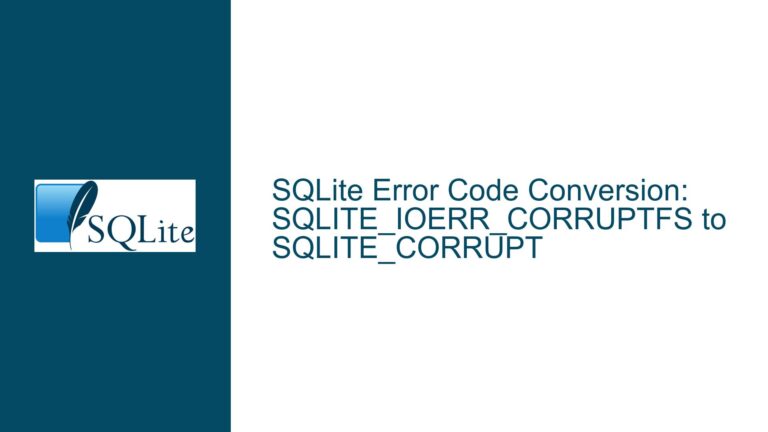Executing SQLite Scripts Within Scripts: Syntax and Best Practices
Issue Overview: Executing External Scripts in SQLite
When working with SQLite, a common requirement is to execute an external SQL script from within another SQL script. This is particularly useful in scenarios where you need to modularize your database operations, such as creating tables, defining triggers, or altering schemas. However, SQLite does not natively support the execution of external scripts directly within SQL statements. This limitation often leads to confusion and errors, especially for developers accustomed to other database systems that provide built-in support for such operations.
In the provided scenario, the user attempts to use the .read command within an SQL script to execute an external script (triggerscript.sql) that defines triggers for a table (TBL). The .read command is a feature of the SQLite Command Line Interface (CLI), not a part of the SQL language itself. Consequently, when the user includes .read triggerscript.sql; within their SQL script, SQLite interprets it as an invalid SQL statement, resulting in a syntax error: near "read": syntax error.
The core issue here is the misunderstanding of the context in which the .read command operates. The .read command is a meta-command specific to the SQLite CLI, designed to read and execute SQL statements from a file. It is not recognized within the SQL language itself, which is why it cannot be used directly within an SQL script. This distinction is crucial for understanding how to properly execute external scripts in SQLite.
Possible Causes: Misuse of CLI Commands in SQL Scripts
The primary cause of the error is the misuse of the .read command within an SQL script. The .read command is a feature of the SQLite CLI, not a part of the SQL language. When you execute an SQL script, SQLite expects valid SQL statements, not CLI commands. Therefore, attempting to use .read within an SQL script results in a syntax error because SQLite does not recognize .read as a valid SQL command.
Another potential cause of confusion is the expectation that SQLite should behave similarly to other database systems that allow the execution of external scripts directly within SQL statements. For example, in PostgreSQL, you can use the \i command within an SQL script to include and execute another script. However, SQLite does not provide an equivalent feature within its SQL language. This discrepancy can lead to frustration for developers who are transitioning from other database systems or who are not familiar with the specific capabilities and limitations of SQLite.
Additionally, the error message near "read": syntax error can be misleading if the developer is not aware of the distinction between SQLite CLI commands and SQL statements. The error message suggests that there is a syntax error near the word "read," but it does not explicitly state that the issue is related to the misuse of a CLI command within an SQL script. This lack of clarity can make it difficult for developers to diagnose and resolve the issue.
Troubleshooting Steps, Solutions & Fixes: Proper Execution of External Scripts in SQLite
To properly execute an external script within SQLite, you need to understand the distinction between SQLite CLI commands and SQL statements. The .read command is a CLI command, and it cannot be used directly within an SQL script. Instead, you should use the SQLite CLI to execute your scripts, or you can use a programming language with an SQLite library to achieve the same result.
Using the SQLite CLI to Execute External Scripts:
The most straightforward way to execute an external script in SQLite is to use the SQLite CLI. The .read command is specifically designed for this purpose. Here’s how you can use it:
Create Your SQL Scripts: First, create your SQL scripts. For example, you might have a script named
schema.sqlthat defines your database schema, and another script namedtriggers.sqlthat defines your triggers.Execute the Scripts Using the CLI: Open the SQLite CLI and execute your scripts using the
.readcommand. For example:sqlite3 mydatabase.db sqlite> .read schema.sql sqlite> .read triggers.sqlThis approach allows you to modularize your database operations and execute them in sequence using the SQLite CLI.
Using a Programming Language to Execute External Scripts:
If you need to execute SQL scripts programmatically, you can use a programming language with an SQLite library, such as Python, to read and execute the contents of your scripts. Here’s an example using Python:
Install the SQLite Library: If you’re using Python, you can use the built-in
sqlite3module. No additional installation is required.Create a Python Script to Execute SQL Scripts: Write a Python script that reads the contents of your SQL scripts and executes them using the
sqlite3module. Here’s an example:import sqlite3 def execute_script(database_path, script_path): with sqlite3.connect(database_path) as conn: with open(script_path, 'r') as f: script = f.read() conn.executescript(script) # Execute the schema script execute_script('mydatabase.db', 'schema.sql') # Execute the triggers script execute_script('mydatabase.db', 'triggers.sql')This approach provides more flexibility and control over the execution of your SQL scripts, and it can be integrated into larger applications or automated workflows.
Alternative Approaches:
If you prefer to keep everything within a single SQL script, you can manually include the contents of your external scripts within the main script. However, this approach can become cumbersome if you have many scripts or if the scripts are frequently updated. Here’s an example:
Manually Include Script Contents: Open your external scripts and copy their contents into your main SQL script. For example:
-- Main SQL script CREATE TABLE TBL ( ID INTEGER, value TEXT ); -- Contents of triggerscript.sql CREATE TRIGGER update_tbl AFTER UPDATE ON TBL BEGIN -- Trigger logic here END;While this approach works, it is not recommended for large or complex projects due to the lack of modularity and the potential for errors when manually copying and pasting script contents.
Best Practices:
To avoid issues when executing external scripts in SQLite, follow these best practices:
Use the SQLite CLI for Script Execution: When working with SQLite, use the CLI to execute your scripts. This approach is simple and effective, and it allows you to modularize your database operations.
Leverage Programming Languages for Automation: If you need to automate the execution of SQL scripts, use a programming language with an SQLite library. This approach provides more flexibility and can be integrated into larger applications or automated workflows.
Avoid Mixing CLI Commands and SQL Statements: Do not attempt to use CLI commands within SQL scripts. CLI commands are specific to the SQLite CLI and are not recognized within the SQL language itself.
Modularize Your Scripts: Break down your database operations into modular scripts. This approach makes it easier to manage and execute your scripts, and it allows you to reuse scripts across different projects.
Test Your Scripts: Always test your scripts in a controlled environment before executing them on a production database. This helps to ensure that your scripts work as expected and that they do not introduce errors or inconsistencies into your database.
By following these best practices, you can avoid common pitfalls and ensure that your SQLite scripts are executed correctly and efficiently. Whether you choose to use the SQLite CLI or a programming language, understanding the distinction between CLI commands and SQL statements is key to successfully executing external scripts in SQLite.
In conclusion, executing external scripts in SQLite requires a clear understanding of the tools and techniques available. While SQLite does not natively support the execution of external scripts within SQL statements, you can achieve the desired result using the SQLite CLI or a programming language with an SQLite library. By following the best practices outlined in this guide, you can ensure that your SQLite scripts are executed correctly and that your database operations are modular, efficient, and error-free.
